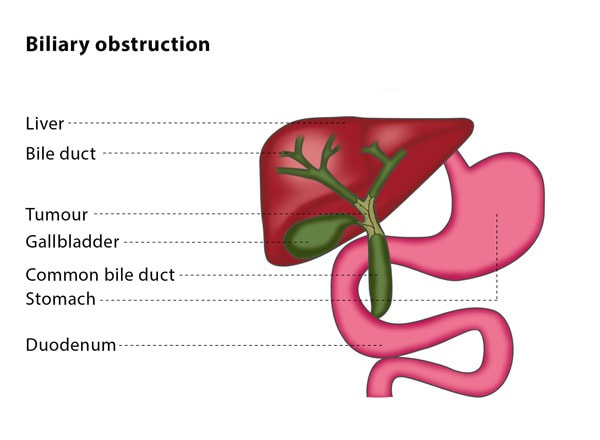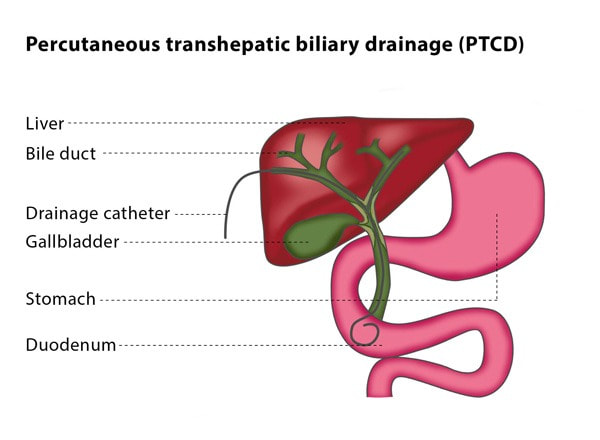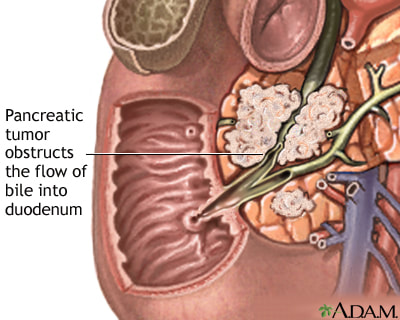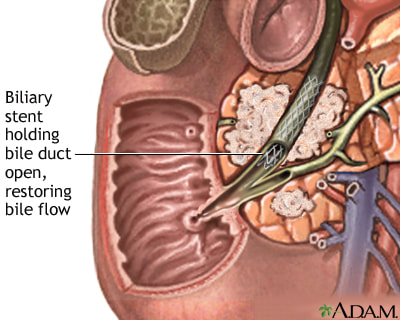Biliary obstruction

Bile is formed in the liver and passes down a series of increasingly large tubes called bile ducts. The ducts are referred to as the biliary tree as the configuration is similar to a tree with its trunk, limbs, and branches. Bile aids in digestion and is moved into the small bowel when food is detected in the stomach.
The gallbladder is a reservoir to hold bile in between meals.
When there is a block of the duct, which most often is caused by tumor or stones, the block can be relieved by placing a catheter or stent across the obstructed duct. This can be placed by a gastroenterology doctor (GI doctor) by endoscopy from your mouth. Or it can be done by an Interventional Radiologist who will guide a needle from the skin, across the liver, and into the obstructed duct.
Since the GI doctor does not have to puncture the liver to place the stent, that method is usually the preferred approach as it is less invasive than the way the Interventional Radiologist does the procedure.
But if the GI doctor is unsuccessful, or you have had prior surgery that blocks that route (like a gastric bypass) we in IR are ready to step in to help.
The gallbladder is a reservoir to hold bile in between meals.
When there is a block of the duct, which most often is caused by tumor or stones, the block can be relieved by placing a catheter or stent across the obstructed duct. This can be placed by a gastroenterology doctor (GI doctor) by endoscopy from your mouth. Or it can be done by an Interventional Radiologist who will guide a needle from the skin, across the liver, and into the obstructed duct.
Since the GI doctor does not have to puncture the liver to place the stent, that method is usually the preferred approach as it is less invasive than the way the Interventional Radiologist does the procedure.
But if the GI doctor is unsuccessful, or you have had prior surgery that blocks that route (like a gastric bypass) we in IR are ready to step in to help.
Biliary drainage
Your STRG IR doctor will likely do the procedure with the help of an anesthesiologist, who will put you to sleep.
The drain is placed from the skin all of the ways to the small bowel, passing through the liver and the biliary tree as well as whatever is obstructing the biliary tree. There are holes along the catheter that allow the bile to drain from above the obstruction down into the duodenum. Or the catheter can be used to drain the bile into a collection bag outside of your body. Since it can drain to the inside or the outside, these are often called Internal/External drains.
The drain is placed from the skin all of the ways to the small bowel, passing through the liver and the biliary tree as well as whatever is obstructing the biliary tree. There are holes along the catheter that allow the bile to drain from above the obstruction down into the duodenum. Or the catheter can be used to drain the bile into a collection bag outside of your body. Since it can drain to the inside or the outside, these are often called Internal/External drains.
Biliary Stent
If the cause of the obstruction is a malignant tumor (cancer) we often convert the biliary drain to a biliary stent which will drain only to the inside. Once we are satisfied that the stent is working, we will remove the drain so that you have no external catheter.




